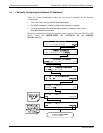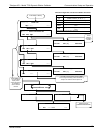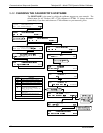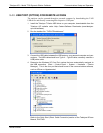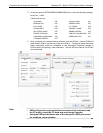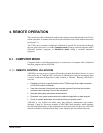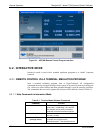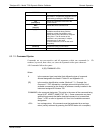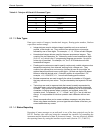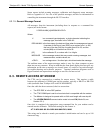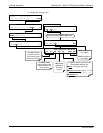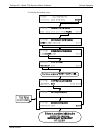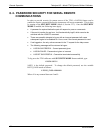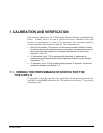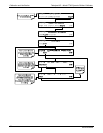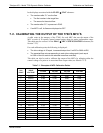
Remote Operation Teledyne API – Model T700 Dynamic Dilution Calibrator
192
Table 6-2: Teledyne API Serial I/O Command Types
COMMAND COMMAND TYPE
C
Calibration
D
Diagnostic
L
Logon
T
Test measurement
V
Variable
W
Warning
6.2.1.3. Data Types
Data types consist of integers, hexadecimal integers, floating-point numbers, Boolean
expressions and text strings.
Integer data are used to indicate integral quantities such as a number of
records, a filter length, etc. They consist of an optional plus or minus sign,
followed by one or more digits. For example, +1, -12, 123 are all valid integers.
Hexadecimal integer data are used for the same purposes as integers. They
consist of the two characters “0x,” followed by one or more hexadecimal digits
(0-9, A-F, a-f), which is the ‘C’ programming language convention. No plus or
minus sign is permitted. For example, 0x1, 0x12, 0x1234abcd are all valid
hexadecimal integers.
Floating-point numbers are used to specify continuously variable values such as
temperature set points, time intervals, warning limits, voltages, etc. They
consist of an optional plus or minus sign, followed by zero or more digits, an
optional decimal point and zero or more digits. (At least one digit must appear
before or after the decimal point.) Scientific notation is not permitted. For
example, +1.0, 1234.5678, -0.1, 1 are all valid floating-point numbers.
Boolean expressions are used to specify the value of variables or I/O signals
that may assume only two values. They are denoted by the keywords ON and
OFF.
Text strings are used to represent data that cannot be easily represented by
other data types, such as data channel names, which may contain letters and
numbers. They consist of a quotation mark, followed by one or more printable
characters, including spaces, letters, numbers, and symbols, and a final
quotation mark. For example, “a”, “1”, “123abc”, and “()[]<>” are all valid text
strings. It is not possible to include a quotation mark character within a text
string.
Some commands allow you to access variables, messages, and other items.
When using these commands, you must type the entire name of the item; you
cannot abbreviate any names.
6.2.1.4. Status Reporting
Reporting of status messages as an audit trail is one of the three principal uses for the
RS-232 interface (the other two being the command line interface for controlling the
instrument and the download of data in electronic format). You can effectively disable
the reporting feature by setting the interface to quiet mode (Section 5.2.1, Table 5-1).
06873B DCN6388



